Top Ten Trees of Yucatan
Editor's Note: We love the trees around here. They grow big and tall, they grow fast, and so many of them have beautiful flowers at certain times of the year. After years of living here, we know some of them by name, and we have an idea about when they bloom, but we always want to know more. So we were happy to see this new article from Jim Conrad, the eternally-curious observer behind the website backyardnature.net. In the following article he gives us a rundown of ten of Merida's most beautiful trees. This is a great article to read for general information, and an important article to read if you are getting ready to plant trees in your garden or around your house in the Yucatan. Enjoy!
Merida's Bodacious Trees
"Bodacious" is a word referring to something drawing attention to itself, and it's a word always used lightheartedly. Each of the following trees draws attention to itself in its own way. The list is offered lightheartedly because we all know that every tree, if you really get to know it, is bodacious.
African Tulip (Spathodea campanulata)
If you see a tree with dark green leaves and very large, scoop-shaped blossoms so strikingly red that, even in a land of many gorgeously flowering trees, you just have to stand and look at it, it's the African Tulip Tree.
A member of the same family as North America's Trumpet Creeper vine and Catalpa tree, the Bignonia Family, African Tulips really are native to Africa. Nowadays this tree is planted in the tropics worldwide because of its beauty. Because of its worldwide distribution, it is known by many names other than African Tulip. For instance, another English name is Santo Domingo Mahogany, though it has nothing to do with real Mahogany. In Spanish it is sometimes called Flor de Fuente (Fountain Flower) because its four-inch-long blossoms curve into cups that hold rainwater for thirsty birds and insects.
African Tulip's pretty flowers might emerge almost anytime, but in the Yucatan they reach a peak around February. The tree is fast-growing and can be reproduced from seeds, root suckers or cuttings. It thrives on the Yucatan's limestone-derived soil, and does best in full sun. One problem with it, though, is that its branches are brittle, making it particularly susceptible to wind injury.
Lebbeck Tree (Albizzia lebbeck)
If you visit Merida only during the dry season (the northern winter), you may have wondered why the city planners so frequently planted a certain tree in the grassy median between so many divided streets. During the winter/dry season those trees are loaded with fairly unsightly, foot-long fruiting pods that dry to a brown, shiny brittleness, and rattle when the wind blows.
What winter visitors don't know is that in the rainy season, around late August, those same trees become exceedingly graceful and pretty, producing abundant fragrant, greenish-yellow, egg-size, powder-puff-like flower clusters. If you've ever known a woman who'd powder-puff herself with scented talc, you might think of her when you walk by this tree, when its honeyed scent concentrates so pleasingly in the rainy season's humid shadows.
We're talking specifically about the Lebbeck-Tree, Albizzia lebbeck, which is a native of tropical Asia and northern Australia. The species is planted widely throughout the world's tropics and can grow to 50 feet high (15 m). "Lebbeck" is its Arabic name. Who knows how this Asian tree came to be known in English by its Arabic name, and how it came to be so commonly planted not only in Merida but also in many of the Yucatan's tiny, isolated Maya villages, where often it provides the shade for men who gather in the afternoon in the central parks.
In the Lebbeck-Tree's flower clusters the slender, fuzzy items are the male parts, the stamens. Each one is topped by a tiny anther that opens to release pollen. In the picture the stamens in some flower clusters are drooping and turning brown after their blossoms have been pollinated, and the stamens are no longer needed.
You might recognize Lebbeck-Tree's genus name, Albizia, for that is the same genus to which North America's much-planted and often invasive Silk-Tree or "Mimosa" (known technically as Albizia julibrissin) belongs.
Silk-Trees produce fuzzy flower clusters like those in the picture, but they are pink. Both species bear ferny, twice-pinnately compound leaves. It is also interesting to note that the Lebbeck-Trees belong to the Bean Family.
Royal Palm (Roystonea regia)
Back during the heyday of henequen, or sisal, production, when Merida was home to more millionaires per capita than any other city on Earth, entry roads to the most elegant plantation mansions often were framed with tall, stately Royal Palms. From the photo you can see where they get their name "Royal." Royal Palms are native to Cuba. A similar species is native to and planted in Florida.
How do you distinguish a Royal Palm from other tall palms with slender trunks?
First, Royal Palms are "feather palms," which means that their fronds'
slender segments arise from a long midrib the way a bird feather's barbs arise from the shaft. "Feather palms" are distinguished from "fan palms," in which the fronds' slender leaf-segments arise from a single point atop the fronds' stems, or petioles. Fan palms you may be familiar with include the palmettos, Washington palms, and Yucatan's thatch palms.
But how are Royal Palms different from other "feather palms," such as the familiar Coconut Palm? If you are planting a very young palm, it might be hard to tell the difference, so these tips might come in handy.
One conspicuous difference is that Royal Palm fronds' slender segments, or "pinnae," arise at several angles from the midrib so that the fronds look a little shaggy, not neatly flat like a chicken feather. The picture shows just how shaggy Royal Palm fronds are.
A second big difference is that Royal Palms have a prominent, green "crownshaft" between the gray bole and its tuft of shaggy fronds, as is easily seen in the first picture.
Notice how the Royal Palm's gray bole is narrowly ringed horizontally. On Royal Palms the bottom, oldest fronds always are drying up and falling off as new, larger fronds emerge above them. Those rings are scars from the bases of old frond stems, or petioles. Old fronds fall mainly during the dry season, and take it from me, you sure don't want to be beneath a Royal Palm when one of its big fronds falls.
Back to those shaggy fronds. Why would such dignified palms permit themselves such disorderly appearing fronds? I think I know the answer. During one dry season in the Yucatan, each early morning I built breakfast campfires beneath some Royal Palms and all during my meals cool water droplets showered onto me. The droplets fell from the palm's shaggy leaves where water had condensed. Much of the Yucatan during the dry season experiences morning fogs and the Royal Palms' shaggy fronds do a great job of wicking fog droplets from the air, producing dark little streamlets of water that drain down the palm's gray trunk, watering the tree when there's precious little rain.
I'll even bet that the bulges that typically appear at the top of a Royal Palm's gray trunk result from this wicked water being stored there. Pretty clever, eh?
Royal Poinciana (Delonix regia)
Of all the "What-beautiful-tree-is-that!" emails I receive, the tree most frequently being referred to is the Royal Poinciana. You can see why in the photo. The letters generally peak at the beginning of the dry season, around May, because that is Royal Poinciana's peak flowering time, though sometimes flowers show up later in the season, especially if the tree is being watered.
The Royal Poinciana's flowers are about 3.5-inch wide and star shaped. The tree's dark-green leaves are 18 inches long and ferny (bipinnately compound) in appearance. The combination of large, scarlet flowers on a frilly, dark green field is just uncommonly pretty.
The Royal Poinciana belongs to the Bean Family and is native to Madagascar. It is so widely planted that it bears many names other than Royal Poinciana... Peacock-flower, Flametree and Flamboyant among them. Its usual Spanish name is Flamboyán or Flamboyán Real.
On the one hand, Royal Poinciana's native forests in Madagascar are being destroyed, largely by locals making charcoal, so the species is on the Red List of Threatened Species. On the other hand, Royal Poinciana is planted abundantly in the tropics worldwide and occasionally "goes wild." When it does escape it can become a weed tree threatening native species who can't compete with the Poinciana's dense root network and shade.
During the Yucatan's dry season, (winter to most of us norteamerianos), if a Royal Poinciana isn't somehow watered, it can become plain ugly. Trees lose part or all of their leaves, and for awhile are decked with innumerable gangly, dark, machete-shaped, woody pods over two feet long. Then the pods fall onto the ground or sidewalk, creating a real mess (but great dog toys!). That's one in the picture. Another thing to keep in mind is that the trees roots spread as far and wide as it's canopy. You wouldn't want to plant this tree too near a wall.
Despite a few drawbacks, most people think the tree's long-term gorgeousness more than compensates for its occasional short-term ugliness, so Royal Poincianas continue to be one of the most planted of all tropical trees.
Golden-Shower Tree (Cassia fistula)
Deep in the rainy season, around September, if you see a handsome shadetree with foot-long, pinnately compound leaves like those of a northern ash tree, and the tree is resplendent with two-inch wide, canary-yellow blossoms densely clustered in foot-long racemes, it's the Golden Shower tree, also known in these parts as Lluvia de Oro.
After flowering, most of the rest of the year the Golden-Shower trees are unremarkable. In mid dry season, around March, once again the tree draws attention to itself, this time with its two-ft-long, very slender and round in cross-section fruits, which look like enormous string-beans. In fact, the fruits are related to string-beans, for the Golden-Shower tree is a member of the Bean Family. When mature, the pods turn black.
The Yucatan's Maya always impress us with their profound knowledge of plants and animals, especially medicinal plants. However, Golden-Shower trees provide a rare instance when the outside world knows more about the medicinal value of a local plant than the local Maya. The Golden Shower trees are alien here, being from India, and so far the Maya don't seem to know that the pod produces between its many seeds a pulp that makes an excellent laxative. In the old days when pharmacists compounded their own drugs from raw ingredients, "cassia pods" from this tree graced the shelves of every small-town drugstore.
Pink Tabebuias (Tabebuia rosea)
Sometimes a flowering tree imprints its presence on a landscape so definitively that the landscape would be a whole other thing without it.
Think of fall in Vermont without sugar maples or Mississippi in late spring without magnolias. In Merida, sometimes certain streets positively shimmer with the presence of Pink Tabebuias.
I'm sort of making up that name "Pink Tabebuia," for the species is planted and admired in so many places that it goes by very many local names, none of which seems to be used more than any other. Among its names are Pink Poui, Pink Cedar, Pink Trumpet Tree, Roble Blanco, Poirier, Poirier Rouge, Kibra Hacha, Hok'ab, Maculiz, Palo de Yugo, Roble, Palo de Rosa... On and on. However, the whole world recognizes its Latin name, so I call it "Pink Tabebuia." The species is a member of the Trumpet-Creeper Family, along with the North's Trumpet Creepers and Catalpas.
In the picture you see Pink Tabebuia's trumpet-shaped flowers as well as its digitately compound leaves (leaves with leaflets arranged like digits, or fingers, on a hand). One distinctive feature of the tree's leaflets is that each leaflet has its own long stem, or "petiolule." During the dry season Pink Tabebuias may lose all their leaves unless they have a water source such as a leaking sewage drain. They reach their peak of flowering in the dry season, around February. Few things are prettier than a leafless Pink Tabebuia in full bloom on a sunny, blue-skied day in the Yucatán.
Pink Tabebuia is one of few native Yucatecan trees doing large-scale street service here. Since it is a native plant, it is mentioned in Maximino Martínez's classic Plantas Medicinales de México, where it is reported that a tea brewed from its bark and leaves traditionally has been used to bring down fevers.
Blue Jacarandas (Jacaranda mimosifolia)
In the late dry season, around April, all across hot-weather Mexico in towns and along roads -- including Merida -- Blue Jacarandas blossom into gigantic, lilac-colored bouquets. Even if you never look skyward the tree's blossoms are impossible to miss, for they strew the ground beneath trees with blue carpets of flowers. It's worth looking up when you spot these fallen flowers on the sidewalk. For, imagine this: A typically dazzlingly sunny day in the Yucatan with the deep blue sky overhead and you stand looking up through a Jacaranda's branches loaded with translucent, purplish flowers and freshly emerged, ferny leaves, emerald green and wind-shaken, set among deliquescing, black-silhouette branches with sunlight-silvered edges... ah! such beauty!
Blue Jacaranda trees grow up to 50 feet high. They are native to South America but planted worldwide in the tropics, even in southern Florida and places like Phoenix, Arizona and Southern California. Besides being so pretty, jacarandas are popular because they can be grown easily from seeds or cuttings.
Jacaranda flowers are similar in size, shape and structure, but not color, to the above Tabebuias. That's because they are in the same family, the Trumpet-Creeper Family.
Morning Glory Tree (Ipomoea carnea)
In August when you walk along Merida's Paseo de Montejo the most eye-catching flowering plants are the bougainvilleas, oleanders of various flower colors, and Royal Poincianas. One plant with much less of a profile but worth looking for is an eight-foot-tall shrub branching from its base, bearing heart-shaped leaves on long petioles, and abundant cup-size, funnel-shaped, pink flowers. It's the Morning-Glory Tree.
If you know your botanical Latin you'll recognize the genus Ipomoea as the true morning-glory genus. Therefore, this plant is a morning-glory in every respect, despite the fact that morning-glories are "supposed" to be herbaceous vines, at least in the minds of temperate-zone plant lovers.
Tree Morning-Glories are native to our area and much of tropical America.
At first glance, because of their beauty, ease of propagation and general toughness, you would think they deserve to be planted much more than they are. However, beyond tropical America the species behaves as an invasive that threatens native plants. Planting this tree/flower is prohibited in Florida and Arizona. In Paraguay it is regarded as an aggressive weed in wetlands and a page on the Internet reports that it is "found all over India." Despite all that, here in its native land where its enemies have coevolved with it and thus will keep it from "going weedy" as it has elsewhere, it still deserves to be planted more frequently than it is.
Medicinally, Tree Morning-Glory's roots are boiled to use as laxative and to provoke menstruation, and the milky sap is used by traditional healers for skin diseases. However, this concoction is dangerous when used wrong, for it is a depressant on the central nervous system, and a relaxant for muscles. In addition, you should know that it is regarded as poisonous for cattle.
Oleander (Nerium oleander)
My little Golden Nature Guide called "Exotic Plants" refers to Oleanders as "the most popular ornamental of all warm areas." As the picture shows, Oleanders have pretty flowers. There are white-, pink- and red-flowering Oleander varieties to choose from, which is great, but there must be something additional accounting for their popularity.
The "something else" is that they are tough plants that thrive in such places as never-watered, air-polluted, dog-peed-on green spaces separating avenue lanes -- something easy enough to confirm throughout Merida. Oleanders are also favored in such semitropical and non-tropical places as California, deep Texas, and the US Carolinas' coastal islands where their salt tolerance helps them survive.
One feature detracting from the Oleander's excellence as an ornamental shrub, however, is that all parts of the plant are highly poisonous.
The flowers in the picture are double-flowered horticultural monstrosities, as I suppose most garden Oleanders are nowadays. In double-flowered varieties of most ornamental plants, the plant breeder has usually caused the male, pollen-producing stamens or other parts of the flower to abnormally develop into colorful petals. For example, wild rose flowers bear only five petals, but most rose blossoms produced in gardens have dozens of petals, which are derived from stamens, to make the flowers bigger and brighter.
If you don't believe that, the next time you're next to a many-petaled garden rose, if you look closely you may find some petals that are "half petal, half stamen" -- maybe a small petal with a yellow anther on one side. The same may be true of the more showy oleanders. Oleanders grow well from cuttings and make a good hedge or screen.
Yellow Oleander (Thevetia peruviana)
In the late rainy season, around September, in towns large and small all across the Yucatan and the rest of tropical Mexico, one of the most eye-catching flowering plants is the Yellow Oleander, whose yellow, 2.5-inch-long flowers, black fruits and willow-like leaves make it very easy to identify.
Yellow Oleander is completely different from the Oleander described above. The two oleanders do belong to the same family, the Dogbane Family, or Apocynaceae, but they reside in entirely different genera. Yellow Oleanders bear one leaf at each stem node (they are alternated) and the fruit is that curiously fleshy drupe shown in the photo. The leaves of just plain Oleanders mostly occur in groups of three, and the fruits are slender, okra-pod-like, dry fruits, or follicles, that open along one side when releasing seeds. One feature the two oleanders share, however, is that all parts of both plants are toxic.
Yellow Oleander's thick, four-sided, black fruit is unusual. It's green when immature, then turns bright, glossy red, and finally it becomes the dull black shown in the picture. Inside the fruit resides a smooth, brown stone sometimes called a "lucky nut." Enterprising natives have been known to string lucky nuts on necklaces and sell them as charms for carrying in the pocket.
Parts and Functions of the Flower
Since this is our last bodacious tree, I want to give you a taste of the fun you can have if you really pay attention to how flowers are put together. Yellow Oleander's blossoms are large enough for us to easily see some of the flowers' basic anatomy, making it easy to figure out what does what in the Yellow Oleander flower.
Yellow Oleander flowers are funnel-shaped -- a narrow corolla tube flares out above. The area where the narrow basal tube abruptly enlarges can be referred to as the "throat," and it's in the throat area where the Yellow Oleander flower does something interesting, as shown below:
Above the inset at the lower right there's a kind of barrier across the top of the throat. The inset shows it from above. The larger image at the left shows the throat area in longitudinal-section, with the female stigma and style repositioned to the right of the tube so you can see better other features of the blossom's throat. Normally the stigma and style reside in the very center of the throat and tube.
>
Now imagine that you're a bug drawn into the funnel-shaped flower by its sweet fragrance. When you reach the throat you encounter the star-shaped barrier at the picture's lower right. The sweet odor attracting you issues through the star's "arms," for those "arms" are nothing but holes congested with soft hairs pointing inward toward the holes' center. Where the hairs meet in the center of each hole there's an opening a bug might shove through, so you, the bug, do just that in pursuit of that sweet smell.
In the picture of the longitudinal section at the left, the star-shaped barrier you just passed through is seen as the fuzzy "roof" at the top of the image, just above the labeled anthers. Once you've passed the fuzz barrier, you need to squeeze between the barrier and the hat-shaped stigma head. If you're carrying pollen from another flower, now is when you deposit it on the stigma head, thus accomplishing the first thing the flower wants you to do. You've just pollinated the flower.
Once you're past the broad stigma head it's easy going the rest of the way down to the nectar, especially since the hairs below the star-shaped barrier all point downward, as clearly seen in the photo.
Once you have your nectar and you're leaving the flower, once again the throat area blocks you with all those downward-pointing hairs, this time poking you in the face. However, in the image at the left, notice the glossy, hairless bulges rising below each anther and between the tufts of downward-pointing hairs. Also note how downward-pointing hairs are absent below the bulges. In other words, you can avoid the downward-pointing hairs by entering one of five hairless "doors," then mounting the hairless mound your door leads to.
At the hairless mound's top you're blocked by the bottom of the stigma and have to squeeze between the mound and the stigma bottom to get out. Notice that the stigma's bottom is notched. These notches invite you to exit in particular places. It happens that the arrangement of hairs, stigma-bottom notches and bulges all oblige you to rake past a pollen-coated anther on the way out, and naturally that's the second job the flower wants you to do -- to carry its pollen to the stigma head of another blossom, so pollination can be repeated there.
Once you've scraped past the anthers it's just a matter of going through a star-arm hole like the one you entered, then flying to the next blossom. Whew! A bug's work is never done!!
When the Yellow Oleanders and all the other trees we have talked about are flowering, this incredible bug workout takes place around us all the time. And that is bodacious!




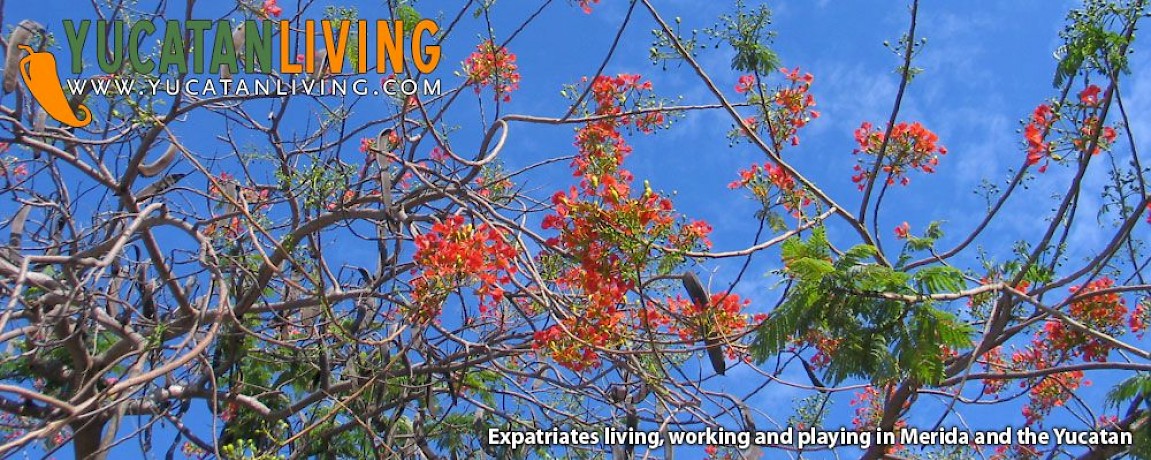


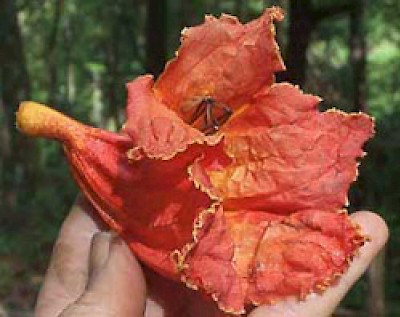
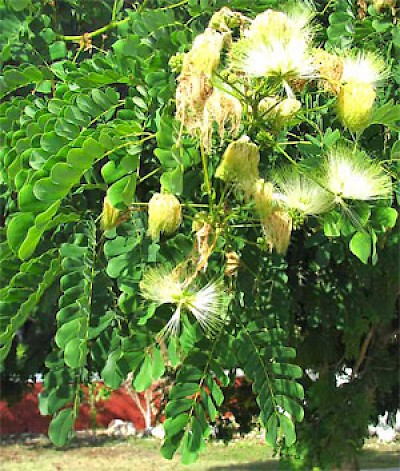
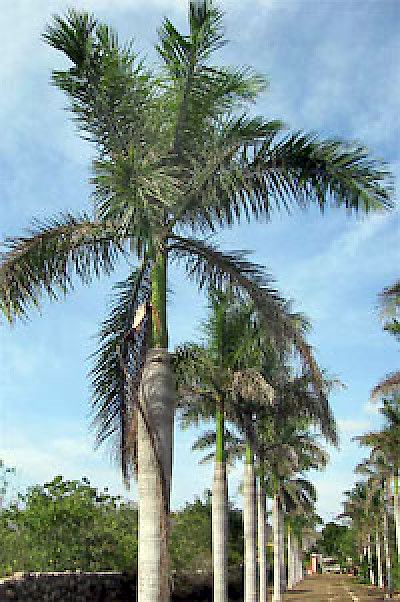
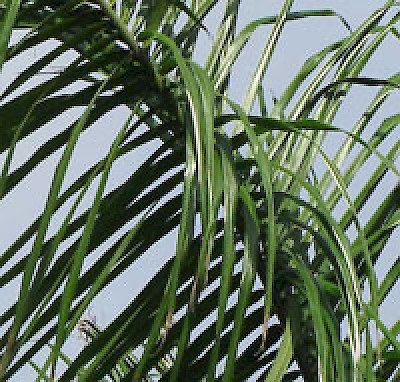
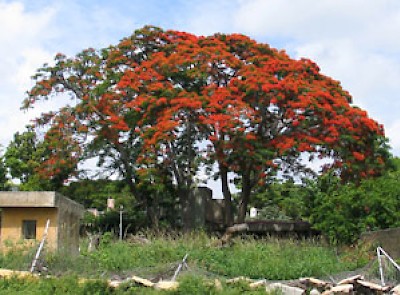
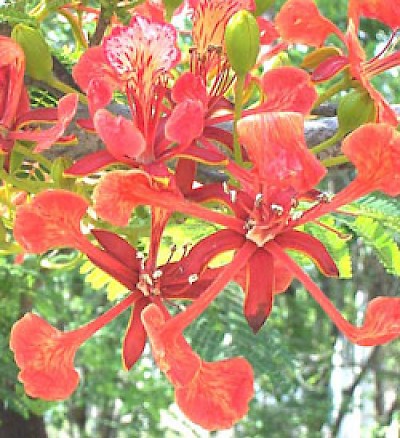


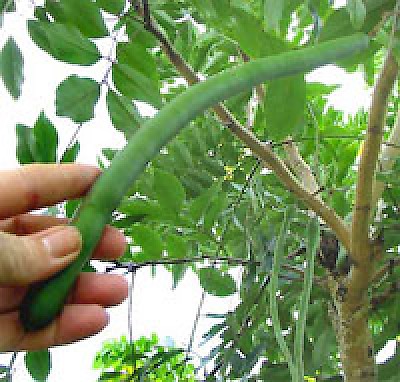
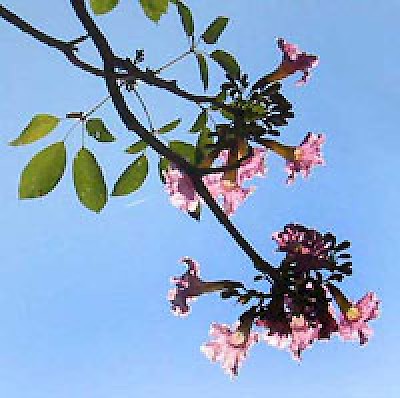
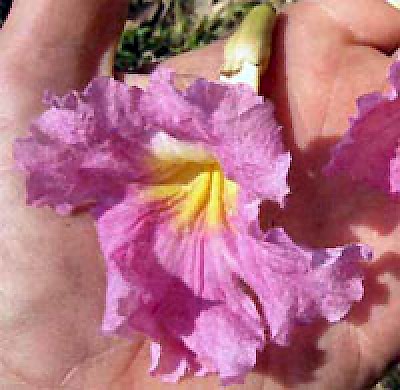
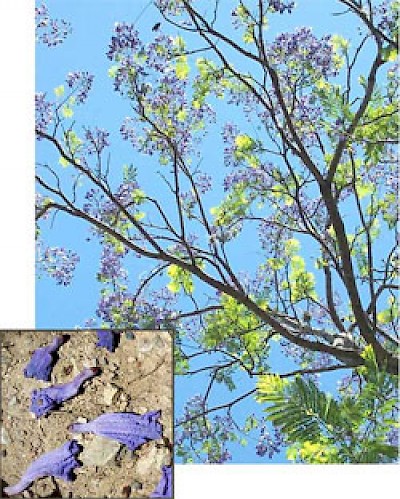
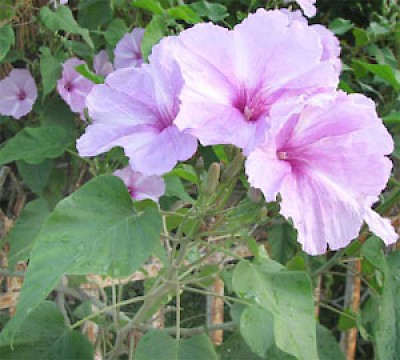
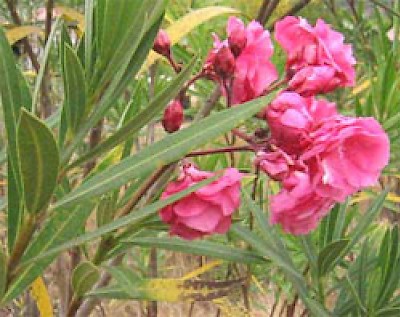
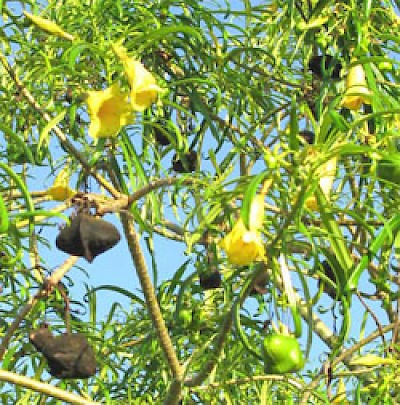
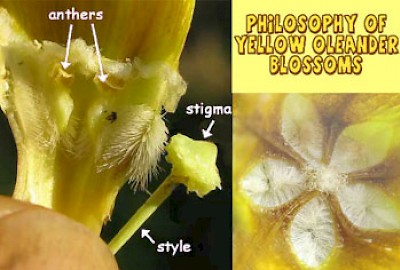
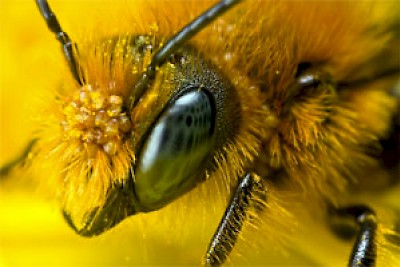

Comments
Keith 7 years ago
Thank you for the great description of the trees. If possible would you know where a rio red grapefruit tree can be purchased in the Yucantan area. Looking for 2 for my yard space.
Regards
Reply
John Ehrenberg 7 years ago
My wife Perla and I live in Cholul, just outside Merida. We planted a large collection of Mayan fruit trees in our garden. This was 30 years ago. Good thing as many of these are now rare and difficult to come by. Six months ago we decided to establish the very first Mayan Fruit Tree Arboretum in the main square of Cholul. We donated the seedlings, attracted a group of volunteers to help take care of the Arboretum and put up signs with the scientific classification identifying trees both in Spanish as well as in Mayan. There is a beautiful 17th century colonial church with frescos and even a cenote in our main square next to the Arboretum, worth a short trip from downtown Merida. There are many Cassia fistula (golden rain tree) in the park, just finished blooming,. We recently (with the help of the Major's office and our volunteers) over 200 Tabebuiae rosae (pink trumpet tree) along the main entrance to Cholul. Come and visit this nice little town just beyond the Periferico and a few minutes from Altabrisa shopping mall.
Reply
Rosy 9 years ago
We'll be moving to Churburna soon. I'm looking for a Mexican equivalent to the Mimosa tree that grows in the Southern US. Any ideas?
Reply
Working Gringa 9 years ago
Yes, there is a similar tree that grows in Yucatan. I believe its called 'acacia' or 'chacha' here. You can read more about it here: http://www.backyardnature.net/yucatan/lebbeck.htm
Reply
Working Gringos 12 years ago
Sara, thanks for your comments :-)
Reply
Sara Thomas 12 years ago
I stand corrected. After reading Jim Conrad's explanation that the thorns are only on young trees and do not denote the gender, I've come to believe that my Maya friend was wrong. Please disregard the above comment or delete is as it is incorrect.
Thanks, Sara
Reply
Sara Thomas 12 years ago
Yes, the Ceibo (Erythrina crista-galli), the national tree of Argentina and Uruguay is different from the Ceiba of the Yucatán. (Ceiba Pentandra Gaerm)
A Maya from Ochil told me how to easily tell the Yucatán CEIBO from the Yucatán CEIBA. Look at the bark. The Ceibo has large thorns on the bark. The Ceiba has a smooth bark...a huge difference. It is also called the Kapok Tree.
Reply
Marion 13 years ago
We have seen trees in the Quintano Roo state that are in the roads, and you have to drive around them. They are very green with a large leafy ball and have a beautiful orange flower and look somewhat like the cieba tree. We were told by someone that they are "bat trees" and protected and that if a road is going there, they have to leave the tree, hense the tree in the middle of a road in Playacar and a few feet into the road in Puerto Aventuras. Does anyone know what they really are? Didn't see it here.
Reply
Working Gringos 13 years ago
Ava, we hope you are able to come back and see more flowers in Mexico! Thanks for writing to Yucatan Living :-)
Reply
Ava Visconsi 13 years ago
I've been to Mexico and I've seen some of those flowers. I was 7when I went to Mexico, but now I'm 9.
Reply
(0 to 11 comments)Next »